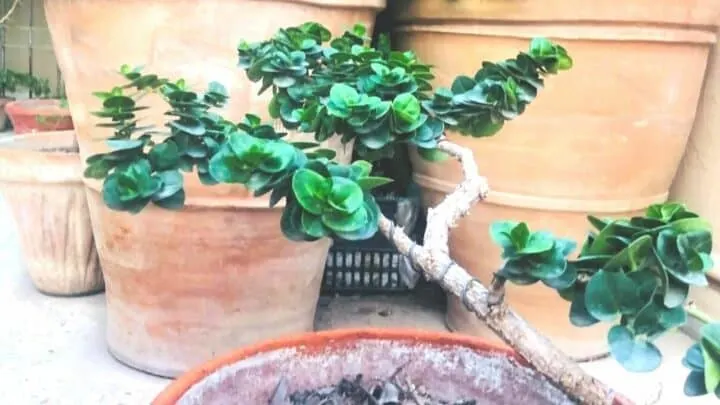Also known as the Natal Plum, Carissa macrocarpa is an ornamental plant native to South Africa.
This plant is known by some pretty animated names in the local languages, such as large Num-Num in South Africa or Amanthuglu in Zulu.
With dark green, closely set, and leathery oval leaves, Carissa macrocarpa boasts a unique and exotic look in gardens.
With fragrant white blossoms, the plant bears an edible red berry called Noem-Noem.
Table of Contents
Carissa macrocarpa Care
Carissa Macrocarpa plants like well-draining, sandy soil and can thrive in a wide range of soil pH levels. This plant needs direct sunlight for at least 4 hours a day to grow well. Being a drought-tolerant species, it requires minimal water and should be watered bi-monthly. Ideal growing temperatures range from 65°F up to 100°F (18-38°C).
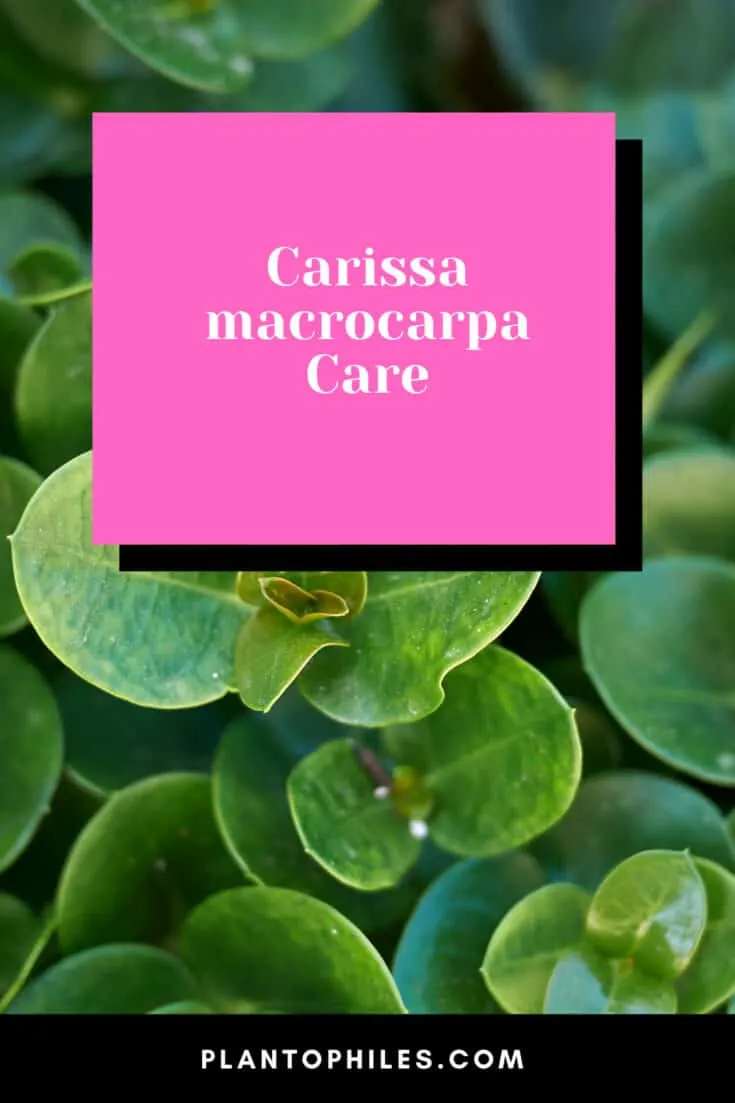
Carissa macrocarpa care
Soil
Carissa Macrocarpa does not have very specific soil requirements and can tolerate any kind of soil as long as it drains well. The plant can tolerate soil pH levels ranging from 6.2 to 7.8. Natal plum is particularly well-suited for seaside plantations as it likes sandy soil.
Being native to coastal regions, Carissa macrocarpa naturally grows in sandy soil with high salt content.
But sandy soil is not essential for this plant to grow well.
This ornamental plant can tolerate a wide range of soil types, the only requirement being good drainage.
The remarkable thing about Natal plum plants is that they can do well in a wide range of pH levels.
They can survive in mildly acidic as well as mildly alkaline soil, from soil pH levels ranging from 6.1 to 7.8.
However, the plant will suffer from chlorosis in highly alkaline soils that are more than pH 8.
Apart from tolerating a wide range of pH levels, Natal plums can also tolerate high levels of salt in the soil, which are otherwise fatal for other plants.
If planting in containers, Carissa macrocarpa will surely do well in any houseplant potting mix.
However, some varieties are susceptible to root rot if the soil does not drain well.
You can add a few parts of sand to the soil if you feel the soil gets too compacted.
Light
Natal plum plants love direct sunlight for a major part of the day. While they need at least 4 hours of sunlight every day, these plants can do well in shady conditions too. However, they will not flower and fruit as well in the shade as in the sun.
Natal plum plants like to grow in open spaces and can tolerate harsh sunlight.
Their dark green foliage may indicate that they can do well in low-light conditions, but they will not thrive as well as they do outside in the sun.
Still, they grow healthy foliage when brought indoors or grown in heavy shade.
You must note that these plants will only bloom and fruit when provided adequate sunlight.
Their blooming ability is seriously hindered when placed in the shade.
If you live in a cold climate, you can bring your Carissa macrocarpa indoors to protect it from the frost.
However, you must give it a window spot that gets at least 4 hours of sunlight every day to keep the sun-loving plant healthy and happy.
If you can’t find a sunny spot indoors, then you’ll have to make do with a grow light to help your Natal plum survive the winter.
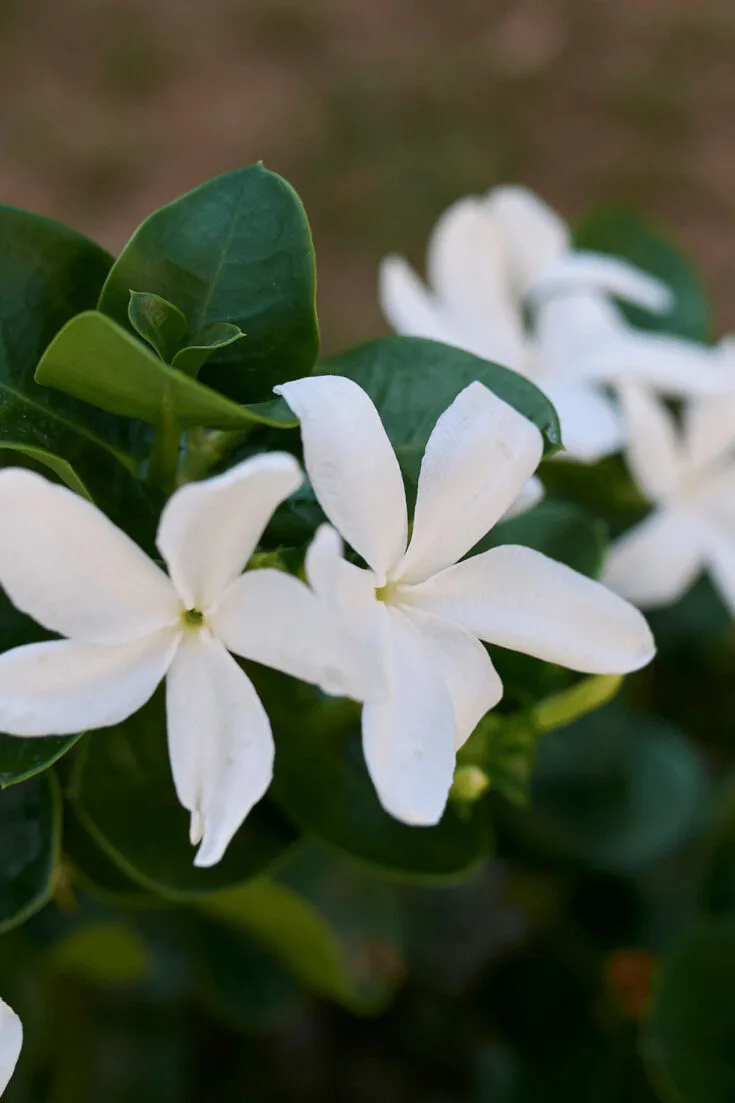
Carissa macrocarpa flowering with white flowers
Watering
Carissa macrocarpa does not require a lot of water and is known for its drought tolerance. Once established in the ground, this shrub might never need you to water it. In containers, it requires water bi-monthly in winters and weekly in summers.
This plant has evolved to grow in harsh conditions and requires water sparingly.
The close-set and relatively thick foliage of the Natal plum allows the coastal plant to reduce its transpiration rates to the bare minimum.
The African shrub is a popular choice in xeriscaping, which is designing plantations that require no irrigation.
A deep watering every time the soil dries out is just what this shrub needs.
Ensure that you are not watering the plant when the soil is already moist.
This plant can survive many things, but if there’s one thing it can’t survive, it’s over-watering.
An excellent method to deep water Natal plum is through soaking. Before you water the plant, check if the soil carries any moisture at all.
If it seems bone dry, place the pot in a tub of shallow water so that it soaks up all the water it needs through the drainage hole.
Temperature
The Carissa macrocarpa is a heat-loving plant that cannot tolerate temperatures below 50°F(10°C). Ideal growing temperatures range from 65°F up to 100°F (18-38°C). This plant does well in USDA Hardiness Zones 9b-11.
Native to the African coastal regions, Carissa macrocarpa can tolerate pretty high temperatures.
The combination of scarce groundwater and heat proves fatal for most plants.
Still, this plant is quite resilient in the face of such challenging conditions.
It is recommended to bring Natal plums indoors to over-winter.
But they can also be left outside if you live in a climate where the temperature does not go below the freezing point at night.
If it gets too cold at night, the plant may start showing signs of chilling injury in the form of reddish-purple leaves.
However, the leaves can immediately heal and turn green when the temperatures warm up.
Humidity
Natal plum plants can survive both extremely high and low humidity levels outdoors. The optimum humidity for this plant is above 60%. If you bring it indoors, you’ll have to maintain a healthy humidity level by placing a humidity tray around the plant.
Carissa macrocarpa is native to coastal areas, where the humidity can go up to 100% when it’s not windy, as well as down to 0% when it’s windy.
This makes the evergreen shrub tolerant to highly fluctuating humidity levels.
The plant performs best when exposed to high heat and humidity. This is when the plant grows rampantly, and its cuttings have a huge chance of rooting.
If you have to bring your Carissa macrocarpa indoors for the winter, make sure you provide it with adequate humidity.
You can use a humidifier or alternatively use a humidity tray under its pot.
Fill the tray with pebbles and flood it with water. This will provide artificial humidity to your plant and keep it thriving.
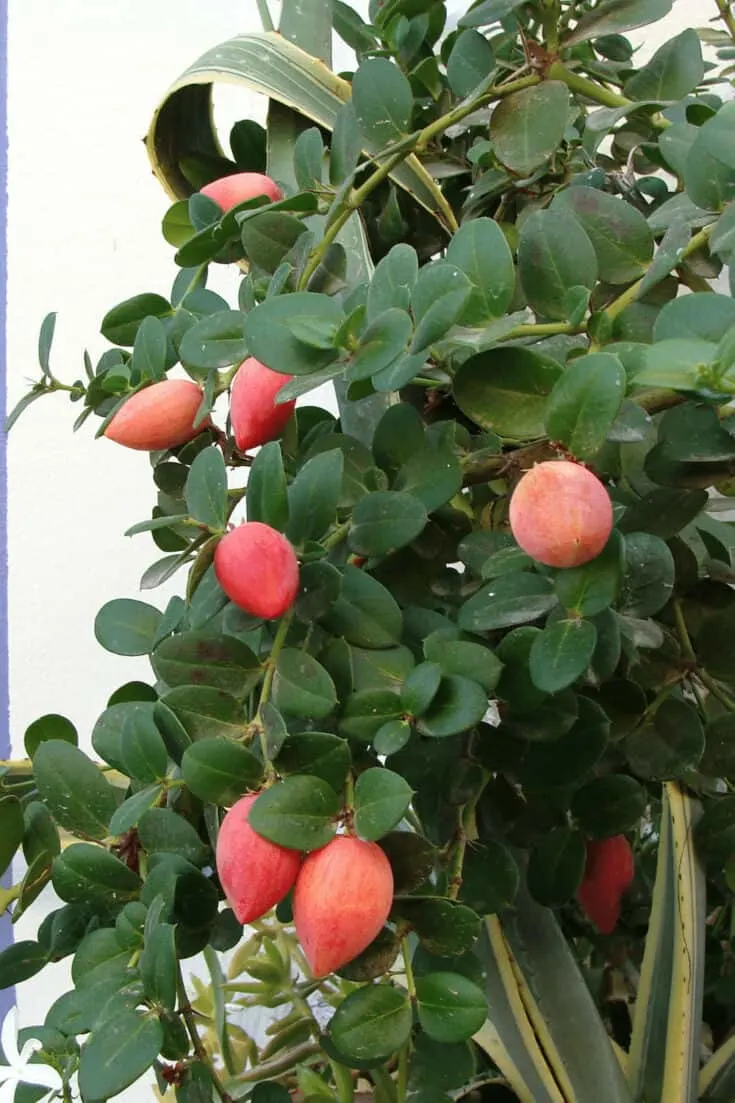
Carissa macrocarpa bearing fruit
Fertilizer
Carissa macrocarpa is not a particularly heavy feeder and can do quite well without any fertilizing if planted in the ground. However, it can be fertilized with general-purpose fertilizer to boost its growth and blossoms. Fertilizer is especially needed when growing Natal plum in pots.
As a plant that can grow well in salty and dry soil, the luxury of growing in regular garden soil is more than enough to sustain a healthy Carissa macrocarpa.
However, you can make its life even better my moderate applications of organic fertilizer.
Although it can tolerate slightly alkaline soil, this plant grows better in soil that’s slightly on the acidic side.
For this, you could feed your Carissa macrocarpa coffee grounds or other acidic fertilizer that lowers the soil PH levels.
Growth
This shrub primarily grows horizontally. It can grow 1-2 feet in height and 4-8 feet in width. It grows the most vigorously in high heat and humidity but has a moderate growing speed year-round.
The dark, dense, and glossy foliage contrasting with the light brown and rough texture of its bark is what makes the Natal plum plant stand out from the crowd.
This evergreen shrub is usually grown for decorative purposes, ground cover, and as Bonsai.
The Carissa macrocarpa plant has a habit of growing new buds from bark that looks quite old.
So, if you’re growing it for its aesthetics or as a Bonsai tree, you will find yourself constantly nipping away buds pointing their heads out of the bark every now and then.
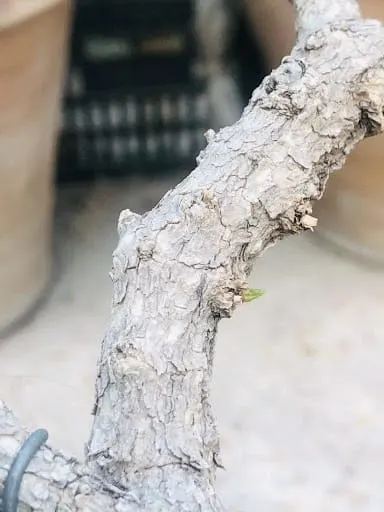
Carissa macrocarpa Stem and Buds
Although the new buds growing out of the trunk can be an inconvenience, you can use this growth habit in your favor too.
New dense growth can quickly sprout out if you prune back hard, giving the plant a more beautiful look.
Potting
To pot a Natal plum, use a pot that is at least 30% bigger than the initial rootball size to sustain healthy root growth. The pot must have drainage holes at the bottom. Using a clay pot is recommended. For growing as a Bonsai, choose a pot that can support wide root growth to balance the plant.
Carissa macrocarpa has a horizontal growth habit. For the branches to grow horizontally, the roots have to do the same to balance the plant.
Along with horizontal root growth, the roots of a Natal plum also go deep, which makes the shrubs stand firmly in strong coastal winds.
To cater for healthy root growth, choose a large pot for your Natal plum.
However, if you’re growing it as a Bonsai, get a pot that is wide enough so that the roots can grow horizontally.
Pruning
The Carissa macrocarpa responds very well to pruning and can be easily shaped into a hedge or Bonsai tree. It can be pruned at any time of the year. Pruning in spring or summer will result in vigorous growth of new buds.
This beautiful plant typically grows horizontally, and you might find it taking over your garden space very soon.
It can always be pruned back to shape, and the good news is that it will spring back with more gorgeous shape and foliage than before.
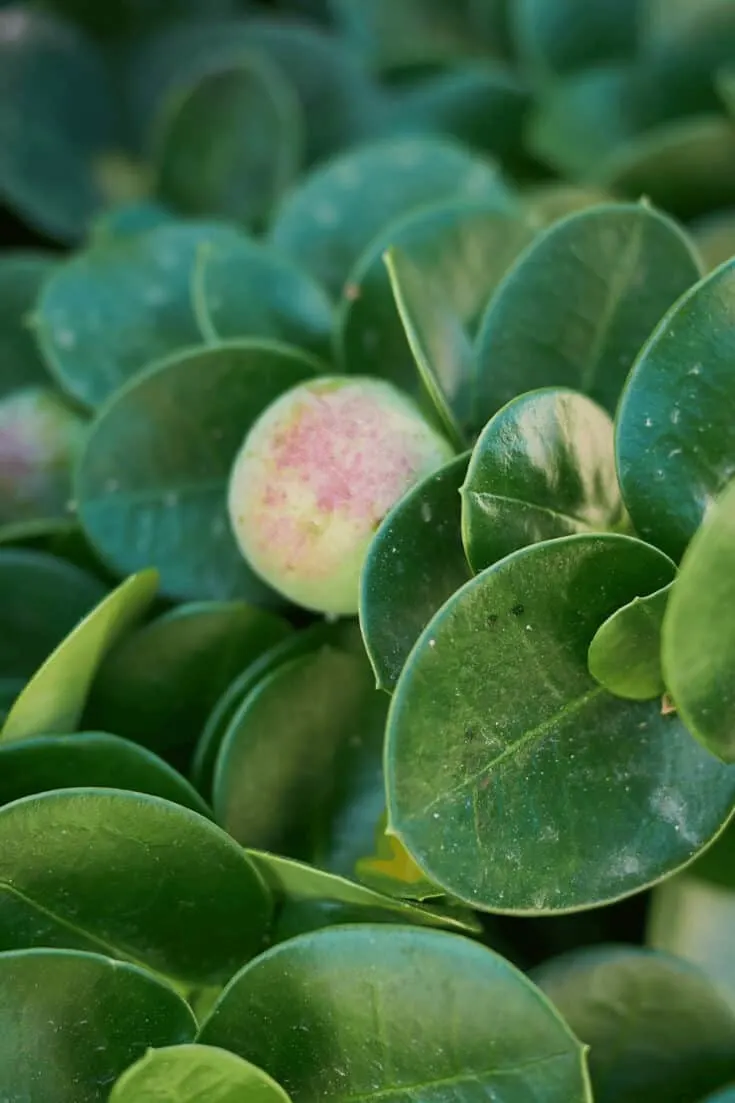
Succulent Carissa macrocarpa leaves
Carissa macrocarpa Propagation
Carissa macrocarpa can be easily grown from seed. It only takes 2-4 weeks for the seeds to germinate and grow into a new plant. Natal plum can also be propagated from cuttings. However, only lignified cuttings have a good success rate.
The broadleaf shrub grows easily from seed and can start bearing fruit within two years.
Even if the fruit falls to the ground and is covered by soil, seedlings spring up in a few weeks.
Vegetative propagation is a faster method to propagate Carissa macrocarpa.
However, the method is not as simple as growing other plants from cuttings.
To grow the plant from cuttings, cut each stem halfway through, leaving half of it attached to the mother plant.
The stem will callus at the cut point over two months.
Remove the cuttings once they have lignified and place them in a moist sandy mix under shade.
The cuttings will root under a month from the date of planting.
Common Problems with Carissa Macrocarpa
The Carissa macrocarpa is a pretty tough plant and isn’t an easy target for pests or diseases.
This evergreen shrub will usually stay clear of any problems if your watering practice is consistent.
Over-watering can lead to a range of different issues for this plant.
Not only will excess soil moisture lead to root rot, but watering excessively can also lead to a fungal infestation.
The closely set leaves of the Natal plum are not supposed to stay wet for extended periods.
If they do, they become perfect breeding grounds for fungi.
To avoid this, water the plant only when needed and use the soak method rather than watering from the top.
Frequently Asked Questions About Carissa macrocarpa
When does a Carissa macrocarpa bear fruit?
Carissa macrocarpa takes around two years to mature before it blooms and fruits. It produces fruit later in the growing season, in late summer or fall.
Is Carissa macrocarpa poisonous to animals?
Animals should be kept clear of this plant because apart from the edible berry, other parts of the plant are poisonous if ingested.
Does Carissa macrocarpa have thorns?
Not all varieties of Carissa macrocarpa have thorns. Some can have huge thorns, while some have none.
Conclusion
The Carissa macrocarpa is one of the easiest plants to care for.
It can survive days on end without water and can do well in shade and sun alike.
And if you take special care of this evergreen beauty, it may as well reward you with sweet Noem-Noem.
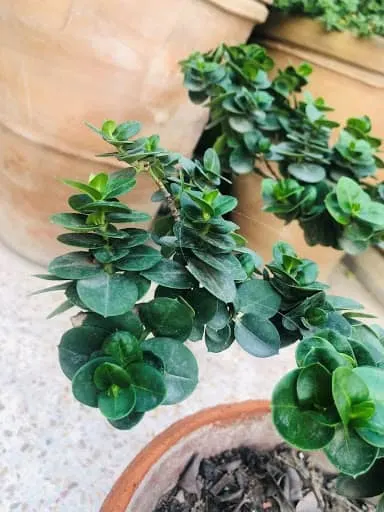
Natal Plum

Daniel has been a plant enthusiast for over 20 years. He owns hundreds of houseplants and prepares for the chili growing seasons yearly with great anticipation. His favorite plants are plant species in the Araceae family, such as Monstera, Philodendron, and Anthurium. He also loves gardening and is growing hot peppers, tomatoes, and many more vegetables.

